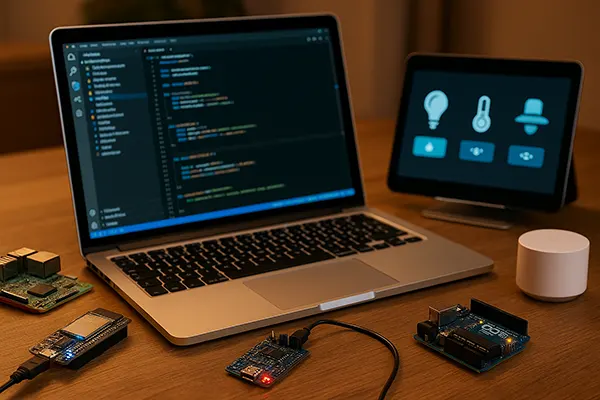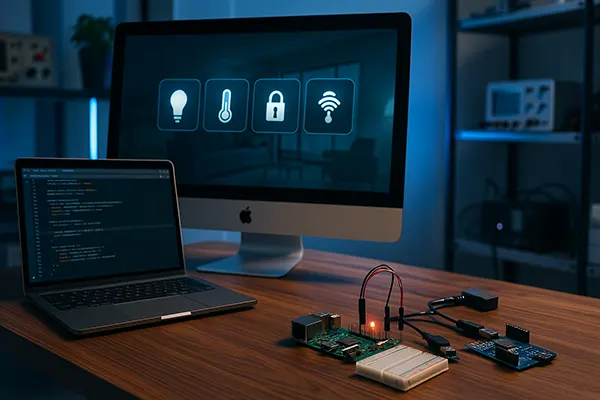Emulators for IoT and Smart Home Devices on macOS

As smart homes and connected devices become part of everyday life, developers increasingly seek ways to test and debug IoT solutions without the need for physical hardware. On macOS, a range of emulators makes it possible to simulate the behaviour of popular microcontrollers, sensors, and communication protocols. These tools save time, cut development costs, and ensure that projects can be verified before deployment to real devices.
How to Emulate ESP32, Arduino, and Raspberry Pi on macOS
Developers using macOS can access several emulation tools designed for major IoT platforms. For ESP32, QEMU-based emulators and ESP-IDF’s own testing environments allow simulation of the firmware, GPIO, and networking layers. Arduino projects can be tested through SimulIDE or Wokwi, both of which offer intuitive graphical interfaces to emulate hardware behaviour.
When it comes to Raspberry Pi, tools like Pi VirtualBox images or QEMU with Raspberry Pi kernels enable running a full Raspbian system directly on a Mac. This setup is ideal for developers who wish to prototype automation scripts or MQTT-based communication before transferring to real hardware.
For advanced testing, combining macOS virtualization with Docker containers allows integration with home automation frameworks such as Home Assistant or OpenHAB. This lets users create a realistic simulation of connected devices that respond to virtual triggers and data flows.
Testing Smart Home Applications and Sensors
Smart home development often involves testing mobile apps that manage lighting, climate control, or motion detection. Emulators on macOS allow developers to replicate the behaviour of these systems using simulated sensors and virtual MQTT brokers.
For instance, when testing an app that communicates with a smart thermostat, it is possible to emulate BLE (Bluetooth Low Energy) connections and Wi-Fi communication through network simulation tools. This makes it easier to evaluate performance under real-world latency and packet loss conditions.
In addition, using virtual sensors—such as temperature or humidity feeds generated by scripts—enables developers to validate automation rules within smart home systems. These scenarios help ensure the reliability of device responses before physical deployment.
Integration with Android Emulators and Cross-Testing
Developers working on mobile interfaces for IoT systems often need to test the interaction between Android applications and emulated IoT devices. On macOS, this can be achieved by connecting Android Studio’s emulator to local virtual devices running MQTT or HTTP servers.
For example, a virtual ESP32 can publish data via MQTT to a broker that the Android app reads, creating a realistic data exchange environment. This type of cross-testing ensures the stability of message delivery, interface responsiveness, and proper event triggering.
Running both Android and IoT emulators in parallel also allows teams to automate regression testing. It provides an effective workflow for debugging sensor data interpretation, user interface commands, and network synchronisation between devices and mobile clients.
Architectural Patterns and CI/CD Integration
Modern IoT projects on macOS often integrate emulators into CI/CD pipelines. This allows for automated firmware testing, verification of device communication, and system integration checks after each code commit. By embedding emulation stages into GitHub Actions or Jenkins, developers reduce human error and detect issues early.
A popular architectural pattern involves separating the emulation layer from the application logic. This approach ensures scalability and modularity, making it easier to reuse simulated environments across projects. It also enables distributed teams to work with identical test configurations without needing physical boards.
Such a setup supports continuous improvement practices by providing immediate feedback on firmware performance and compatibility. As a result, IoT systems developed on macOS achieve higher reliability before release.

The Future of IoT Emulation on macOS
As macOS continues to support new hardware and virtualization technologies, the capabilities of IoT emulators are expanding rapidly. Developers can expect more accurate timing, better peripheral simulation, and enhanced integration with cloud IoT platforms like AWS IoT Core and Azure IoT Hub.
The rise of Apple Silicon has also influenced the evolution of emulators. With M-series processors offering exceptional efficiency, complex IoT simulations involving multiple virtual nodes and communication layers are now possible directly on Mac devices.
In 2025 and beyond, the ecosystem of IoT emulators for macOS will likely grow towards full-stack environments that blend firmware, network, and application simulation. This makes macOS a powerful tool not only for IoT developers but also for researchers and hobbyists in the smart home sector.
Why Emulation Matters for Developers and Enthusiasts
IoT emulation provides a safe and efficient way to innovate without risking hardware damage. It helps both professionals and enthusiasts explore how smart devices communicate and respond to changing inputs. With the right tools, even complex automation scenarios can be built and validated virtually.
For small teams or individual developers, this approach significantly lowers the entry barrier into IoT. Without the need to purchase multiple boards and sensors, one can test logic and connectivity from the comfort of a Mac workstation.
Ultimately, emulation drives progress by encouraging experimentation and accelerating development cycles. It bridges the gap between theory and real-world deployment, shaping the future of intelligent connected systems.
